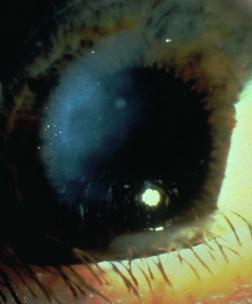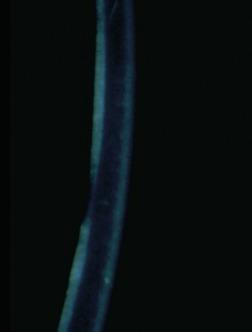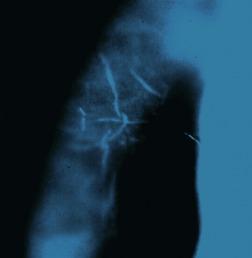Physical Address
304 North Cardinal St.
Dorchester Center, MA 02124
A limited number of reports have been published in the literature detailing the appearance of deep stromal opacities in the eyes of contact lens wearers. As will be discussed in this chapter, the evidence in some of these reports supporting the notion that deep stromal opacities are caused by contact lens wear is not entirely convincing. However, the possibility of a causative relationship in some of the reported cases cannot be discounted. In view of the uncertainty surrounding causation, this condition shall be referred to as contact lens– associated deep stromal opacification.
Reports of deep stromal opacities can be traced as far back as 1982. There have been relatively few publications describing this condition and accounts of the clinical presentation vary considerably. It is therefore not possible to provide a definitive description of contact lens–associated deep stromal opacities. In view of this, each of the reports of this condition shall be reviewed in chronological sequence of their date of publication.
Pinckers et al. observed whitish dots in the stroma of the cornea, resembling a cloudy dystrophy, in four patients wearing hydroxyethyl methacrylate (HEMA) contact lenses. They referred to this condition as ‘contact lens–induced pseudo-dystrophy of the cornea’. A lattice-like corneal pattern was seen in another patient wearing HEMA contact lenses. Corneal sensitivity was normal or reduced.
In 32 long-term contact lens wearers (up to 19 years), deep whitish opacities directly adjacent to Descemet’s membrane were observed by Remeijer et al. in the central part of the cornea. These opacities were seen in HEMA contact lens wearers and polymethyl methacrylate (PMMA) contact lens wearers. Endothelial cell density was normal, but there was marked polymegethism of the endothelium commensurate with the duration of lens wear.
A case of deep stromal opacities is shown in Figure 24.1 . This 24-year-old female patient had been wearing HEMA lenses for only 4 years. There were no visual complaints or reports of discomfort. Viewed using a thin optic section ( Fig. 24.2 ), it can be seen that the opacities are confined to the posterior stroma.


In their review of deep stromal opacification, Loveridge and Larke reported the case of a 42-year-old white Caucasian female displaying deep stromal opacification centrally and slightly inferior to the pupil, and just anterior to Descemet’s membrane ( Fig. 24.3 ). Stellate folds were visible in Descemet’s membrane. The patient had a history of 19 years of PMMA lens wear, followed by 6 years of soft HEMA lens wear. There was a degree of polymegethism and pleomorphism of the endothelium consistent with the duration of lens wear. Her contact lenses had a prescription of R − 3.75 D, L − 5.00 D, and she had worn lenses 13 hours per day without any apparent problems. The patient had been using a care system containing the preservatives chlorhexidine and thimerosal.

Brooks et al. described two cases in which deep corneal stromal opacities occurred after prolonged contact lens wear. The opacities were associated with folds or striae in Descemet’s membrane. Although the corneal endothelial cell counts were within the normal range, the count was reduced in the affected eye in the patient with the unilateral deep stromal opacity, and there was mild polymegethism of the endothelial cells.
Hoang-Xuan et al. reported two cases of patients who had worn soft contact lens for 5 and 8 years on a daily-wear basis. These patients presented with bilateral central avascular haze immediately anterior to Descemet’s membrane, and the haze was associated with mild stromal oedema and Descemet’s folds. Endothelial polymegethism was observed with the specular microscope.
Holland et al. reported six cases where the patients presented with a mottled cyan opacification at the level of Descemet’s membrane. These opacities were located in the peripheral and mid-peripheral cornea. All patients had bilateral findings, and all patients had worn soft contact lenses bilaterally for periods ranging from 7 to 14 years.
Pimenides et al. reported the cases of one male and three female long-term HEMA contact lens wearers (mean age 30.3 years; range 26–33 years) who demonstrated deep stromal opacities which were predominantly just anterior to Descemet’s membrane. None had any history of corneal dystrophy. These opacities were more common centrally but were also identified in the corneal periphery. Lenses had been worn for a mean of 14.3 years (range 10–17 years), and lenses had been worn for a mean of 14.3 hours per day (range 12–16 hours). Specular microscopy disclosed cell densities within normal limits (mean 3,041.5 cells/mm ), and the coefficient of variation of mean cell area was 0.31. Refractive errors ranged from − 12.25 diopter (D) to + 6.25 D best vision sphere.
Confocal microscopy was used by Hsu et al. to examine a 45-year-old white male who presented with 3 weeks of photophobia and foreign body sensation after extended contact lens wear. Initial slit lamp examination showed central stromal opacities, thinning and hyperopic shifts, more in the right eye than in the left eye. Confocal microscopy revealed the presence of collagen fibril oedema and rearrangement with cellular infiltration and sparse refractile elements.
Although Brooks et al. and Hsu et al. noted that the development of the opacities was associated with ocular discomfort and photophobia, other authors suggested that deep stromal opacities are asymptomatic.
The degree of vision loss is variable. Pinckers et al. reported that visual acuity was normal in the four patients they examined. All four patients in the case series reported by Pimenides et al. attained at least 6/9 visual acuity. The six patients examined by Holland et al. had visual acuities of 6/6 or better.
Some authors have reported reduced vision in cases of deep stromal opacification. Vision loss was severe in the two cases reported by Hoang-Xuan et al., and in the case report of Loveridge and Larke, the patient had corrected visual acuity of R 6/18 + L 6/12. Remeijer et al. noted that deep stromal opacities could reduce visual acuity, and the patients examined by Brooks et al. suffered from reduced vision.
Hsu et al. reported that resolution of the opacity was accompanied by a 2.00 D hyperopic shift in refraction.
Become a Clinical Tree membership for Full access and enjoy Unlimited articles
If you are a member. Log in here